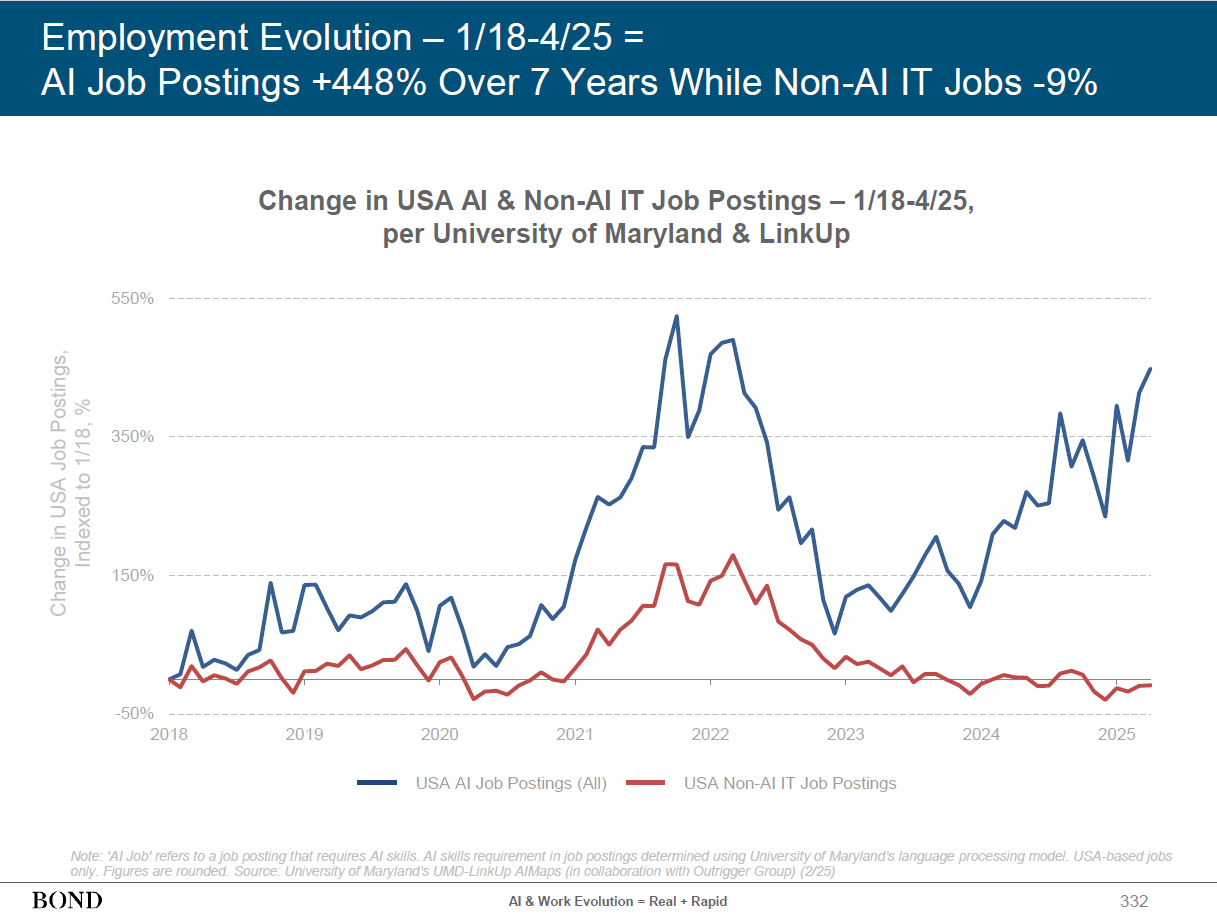Table of Contents
- 1. AI Adoption Outpaces the Internet
- 2. Record Investment and Growth in the AI Ecosystem
- 3. High Training Costs, But Efficient Inference
- 4. Business Models Under Pressure
- 5. Global Competition and Open Source on the Rise
- 6. AI Enters the Physical World
- 7. AI-Driven Internet Access Expansion
- 8. Work and Skills Transformation
- Conclusion
We are living through a historic turning point. Artificial Intelligence, once a futuristic concept, has in just a few months become a transformative force reshaping the game’s rules across every industry—from healthcare to finance, retail to manufacturing. But just how deep—and fast—is this transformation?
One of the most authoritative reports of the year offers answers: “Trends – Artificial Intelligence” a monumental 340+ page analysis published on May 30, 2025. Spearheaded by Mary Meeker—widely known as the “queen of digital trends” for her iconic Internet Trends Report—alongside Bond Capital partners Jay Simons, Daegwon Chae, and Alexander Krey, the report quantifies what many suspect: AI is evolving faster than the internet did in its golden years.
Packed with compelling data, global case studies, and a sharp reading of weak signals, the report brings the future into the present. For businesses and strategic leaders, understanding this shift is no longer optional but necessary.
Here’s a breakdown of the key trends from the report:
1. AI Adoption Outpaces the Internet
AI adoption is accelerating at an unprecedented pace. ChatGPT, for instance, reached 800 million users in just 17 months, with 90% of them located outside North America. AI is spreading faster than the internet did in its first two decades and is expected to reach 50% of U.S. households within just three years.

2. Record Investment and Growth in the AI Ecosystem
Converging forces drive this surge: global internet access, a boom in digital data, user-friendly language models, and an investment race among Big Tech and startups. The numbers are striking: developers on NVIDIA’s AI platform grew by 240% in four years, and AI startups increased by 390%. In 2024, Big Tech companies spent $212 billion in capital expenditures, twice the amount from a decade ago.

3. High Training Costs, But Efficient Inference
While training advanced AI models can cost up to $100 million each, the cost per generated token has dropped by 99.7% in just two years. Thanks to hardware and algorithmic improvements, developer adoption is soaring—63% used AI tools in their workflows in 2024.

4. Business Models Under Pressure
Like Amazon, Uber, or Tesla in their early days, AI follows a trajectory of heavy upfront investment and early-stage losses. For instance, OpenAI incurred $5 billion in compute expenses in 2023, against $2 billion in revenue. Across Big Tech, profit margins are tightening due to skyrocketing AI infrastructure investments.

5. Global Competition and Open Source on the Rise
The number of published AI models has exploded—multimodal models alone grew by 1,150% in just two years. Open-source platforms like Hugging Face are leveling the playing field, narrowing the advantage of proprietary models. Meanwhile, China is emerging as a key player in AI, both in domestic adoption and in developing advanced, accessible models.
6. AI Enters the Physical World
AI is increasingly integrated into the physical realm. Tesla has surpassed 1.5 billion miles in autonomous driving. Waymo now accounts for 27% of rideshare bookings in San Francisco. In agriculture and mining, AI is boosting productivity and sustainability. We’re entering the era of intelligent physical agents.

7. AI-Driven Internet Access Expansion
With 5.5 billion users and 68% global internet penetration, AI-native technologies are enabling broader internet access. In many parts of the world, first-time users are connecting through AI interfaces. The expansion of Starlink and the rise of mobile AI (530 million monthly ChatGPT users) are pushing connectivity into previously unreachable areas.

8. Work and Skills Transformation
AI is reshaping the workforce. Roles linked to AI have grown by 448% over the past seven years. Companies like Duolingo and Shopify are embedding AI at the core of their operations. The goal isn’t just automation—it’s enablement: boosting productivity and creating entirely new professional profiles. As NVIDIA CEO Jensen Huang puts it, “You won’t lose your job to AI—but to someone who uses it better than you.”

Conclusion
At Neodata, we believe AI is not just an emerging technology—it’s a new infrastructure for thinking and business. Understanding its dynamics, risks, and opportunities is essential for any company that wants to stay competitive.

Neodata AI Team
As Neodata, we provide data, insight, articles, and news related to AI and Big Data.
-
Neodata AI Team#molongui-disabled-link
-
Neodata AI Team#molongui-disabled-link
-
Neodata AI Team#molongui-disabled-link
-
Neodata AI Team#molongui-disabled-link